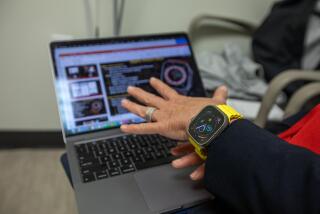Medical Mayhem That’s Funnier Than a Crutch Recounted
- Share via
A farmer in Belfast, Ireland, practiced do-it-yourself cardioversion--slowing a too-rapidly beating heart--for 30 years before finally consenting to have a pacemaker implanted, according to a recent report in the British Medical Journal.
When the palpitations began in 1954, the farmer initially jumped off a barrel in his farmyard, slamming his feet hard when he landed. Later he used a ladder, which was higher. Alternatively, he would fire a 12-gauge shotgun. As his condition began to get more serious, he would take off his clothes and jump into a cold water tank. Finally, he would grasp a six-volt electrical cattle fence, a procedure that worked best when he was wearing hobnailed boots.
At one point, said Dr. J. A. McKnight, a physiologist at the Royal Victoria Hospital in Belfast, the farmer brought his electrical fence into the hospital and demonstrated its use to slow his heart. But they concluded that his methods were “a little extreme for standard medical teaching.”
McKnight’s tale was one of several in the normally staid British Medical Journal’s year-end issue, which is traditionally reserved for stories of the bizarre. The journal saves all its odder submissions over the course of the year, said Editor Steven Lock, and puts them into one issue “that makes a particularly good read for people with their feet up” during the holiday season.
Take the case of the retired rat catcher who thought he had suffered a stroke. To lessen the chances of a recurrence, he treated himself with warfarin, an anti-coagulant that is used to kill rats by making them bleed to death.
“On alternate days he dipped his wet finger into the (warfarin) powder and then sucked it,” according to Dr. R. M. Kirby, a surgeon at the North Stafforshire Royal Infirmary in Stoke-on-Trent. The pest controller finally had to stop his therapy and go to the infirmary when he developed rectal bleeding.
Orthopedic surgeons took a particular beating in the issue. Dr. J. J. Dias, himself an orthopedic surgeon at Glenfield Hospital in Leicester, recounted how a fellow surgeon made a “sweeping incision” just as a colleague took his place by his side. The colleague was stabbed in the stomach.
“Fortunately, his colleague was well-endowed in this area,” so the damage was not severe.
Dias cited another instance in which a colleague trying to insert a metal pin in a broken leg “managed to transfix his assistant’s hand and impale the patient’s other leg, giving a whole new meaning to dynamic external fixation of fractures.”
More to Read
Sign up for Essential California
The most important California stories and recommendations in your inbox every morning.
You may occasionally receive promotional content from the Los Angeles Times.













